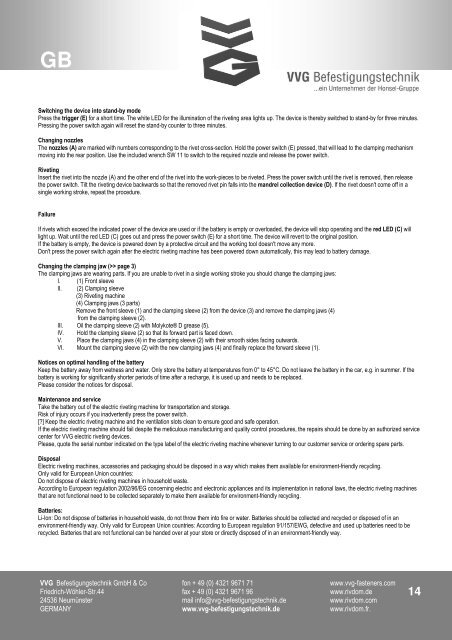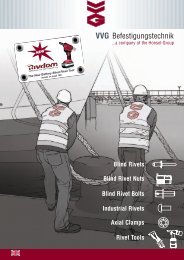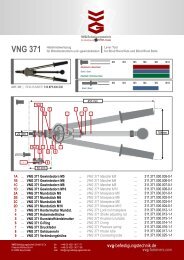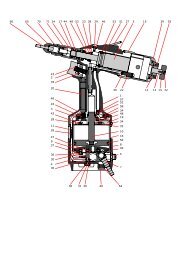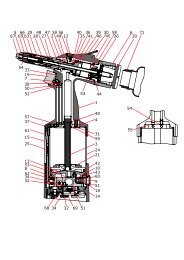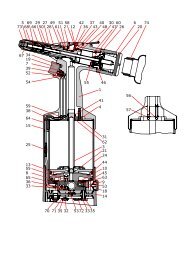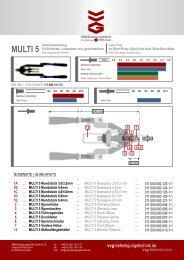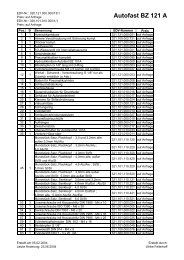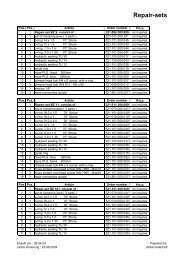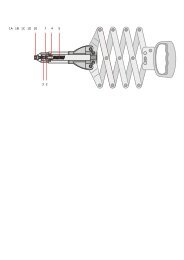GBSwitching the device into stand-by modePress the trigger (E) for a short time. The white LED for the illumination of the riveting area lights up. The device is thereby switched to stand-by for three minutes.Pressing the power switch again will reset the stand-by counter to three minutes.Changing nozzlesThe nozzles (A) are marked with numbers corresponding to the rivet cross-section. Hold the power switch (E) pressed, that will lead to the clamping mechanismmoving into the rear position. Use the included wrench SW 11 to switch to the required nozzle and release the power switch.RivetingInsert the rivet into the nozzle (A) and the other end of the rivet into the work-pieces to be riveted. Press the power switch until the rivet is removed, then releasethe power switch. Tilt the riveting device backwards so that the removed rivet pin falls into the mandrel collection device (D). If the rivet doesn't come off in asingle working stroke, repeat the procedure.FailureIf rivets which exceed the indicated power of the device are used or if the battery is empty or overloaded, the device will stop operating and the red LED (C) willlight up. Wait until the red LED (C) goes out and press the power switch (E) for a short time. The device will revert to the original position.If the battery is empty, the device is powered down by a protective circuit and the working tool doesn't move any more.Don't press the power switch again after the electric riveting machine has been powered down automatically, this may lead to battery damage.Changing the clamping jaw (>> page 3)The clamping jaws are wearing parts. If you are unable to rivet in a single working stroke you should change the clamping jaws:I. (1) Front sleeveII. (2) Clamping sleeve(3) Riveting machine(4) Clamping jaws (3 parts)Remove the front sleeve (1) and the clamping sleeve (2) from the device (3) and remove the clamping jaws (4)from the clamping sleeve (2).III. Oil the clamping sleeve (2) with Molykote® D grease (5).IV. Hold the clamping sleeve (2) so that its forward part is faced down.V. Place the clamping jaws (4) in the clamping sleeve (2) with their smooth sides facing outwards.VI. Mount the clamping sleeve (2) with the new clamping jaws (4) and finally replace the forward sleeve (1).Notices on optimal handling of the batteryKeep the battery away from wetness and water. Only store the battery at temperatures from 0° to 45°C. Do not leave the battery in the car, e.g. in summer. If thebattery is working for significantly shorter periods of time after a recharge, it is used up and needs to be replaced.Please consider the notices for disposal.Maintenance and serviceTake the battery out of the electric riveting machine for transportation and storage.Risk of injury occurs if you inadvertently press the power switch.[?] Keep the electric riveting machine and the ventilation slots clean to ensure good and safe operation.If the electric riveting machine should fail despite the meticulous manufacturing and quality control procedures, the repairs should be done by an authorized servicecenter for <strong>VVG</strong> electric riveting devices.Please, quote the serial number indicated on the type label of the electric riveting machine whenever turning to our customer service or ordering spare parts.DisposalElectric riveting machines, accessories and packaging should be disposed in a way which makes them available for environment-friendly recycling.Only valid for European Union countries:Do not dispose of electric riveting machines in household waste.According to European regulation 2002/96/EG concerning electric and electronic appliances and its implementation in national laws, the electric riveting machinesthat are not functional need to be collected separately to make them available for environment-friendly recycling.Batteries:Li-Ion: Do not dispose of batteries in household waste, do not throw them into fire or water. Batteries should be collected and recycled or disposed of in anenvironment-friendly way. Only valid for European Union countries: According to European regulation 91/157/EWG, defective and used up batteries need to berecycled. Batteries that are not functional can be handed over at your store or directly disposed of in an environment-friendly way.13<strong>VVG</strong> <strong>Befestigungstechnik</strong> <strong>GmbH</strong> & <strong>Co</strong> fon + 49 (0) 4321 9671 71 www.vvg-fasteners.comFriedrich-Wöhler-Str.44 fax + 49 (0) 4321 9671 96 www.rivdom.de24536 Neumünster mail info@vvg-befestigungstechnik.de www.rivdom.comGERMANY www.vvg-befestigungstechnik.de www.rivdom.fr.14
F<strong>Co</strong>nsignes de sécurité générales<strong>Co</strong>nsignes générales de sécurité pour les riveteuses sur batterieVeuillez lire attentivement toutes les remarques et consignes de sécurité. Le non respect de toutes les instructions ci-dessous peut entraîner des accidents telsque des chocs électriques, des incendies et/ou des blessures graves.Veuillez conserver toutes ces instructions de sécurité pour un usage futur.Le terme ‘’riveteuse électrique" utilisé dans les consignes de sécurité ci-après désigne aussi bien le chargeur <strong>Rivdom</strong> fonctionnant avec un fil électrique que lariveteuse sur batterie, sans fil.1. Sécurité de l'espace de travaila) <strong>Co</strong>nservez votre espace de travail propre et lumineux pour éviter les accidents.b) N'utilisez pas la riveteuse sur batterie dans un environnement explosif par exemple à proximité de liquides inflammables, de gaz ou depoussière. Les riveteuses sur batterie créent des étincelles qui peuvent enflammer la poussière ou les vapeurs.c) Tenez les enfants et visiteurs à l’écart lorsque vous utilisez la riveteuse sur batterie.Ils pourraient vous distraire et vous faire perdre le contrôle de l’outil.2. Sécurité électriquea) Le cordon d’alimentation de la riveteuse doit être adapté à la prise de courant et ne doit pas être modifié. N'utilisez pas d'adaptateurs surles riveteuses électriques pourvues de fiches avec contact de mise à la terre. Les fiches et prises inchangées réduisent le risque de chocsélectriques.b) Évitez tout contact corporel avec des surfaces mises à la terre telles que les tuyaux, les radiateurs, les cuisinières électriques, et lesréfrigérateurs. . Les risques de chocs électriques augmentent si une partie de votre corps est en contact avec des surfaces mises à la terre.c) N'exposez pas les riveteuses électriques à la pluie ou à l'humidité :les risques de chocs électriques augmentent si de l’eau pénètre dans un outil électrique.d) Veillez à maintenir le cordon électrique en bon état. Ne tenez jamais votre outil par le cordon d’alimentation et ne tirez jamais sur le cordonpour le débrancher. Maintenez le cordon d’alimentation éloigné de toute source de chaleur, d’huile, d’objets tranchants et d’éléments enmouvement. Les risques de chocs électriques augmentent si le cordon est endommagé ou emmêlé.e) Si vous utilisez la riveteuse électrique à l’extérieur, utilisez uniquement des rallonges conçues pour une utilisation à l’extérieurpour éviter ainsi le risque de choc électrique.f) Si vous êtes contraints d’utiliser votre riveteuse électrique dans un environnement humide, utilisez un disjoncteur de courant.L'utilisation d'un disjoncteur de courant réduit les risques de choc électrique.3. Sécurité personnellea) Restez vigilant, regardez ce que vous faîtes et faîtes preuve de bon sens lorsque vous utilisez la riveteuse électrique.N'utilisez pas votre riveteuse lorsque vous êtes fatigué, si vous êtes sous l’emprise de l'alcool, de drogues ou de médicaments. Un momentd’inattention peut suffire pour vous blesser gravement.b) Portez des vêtements de protection adéquats et protégez toujours vos yeux.Selon les conditions, portez également un masque anti-poussière, des chaussures de sécurité, un casque ou des protections auditives pouréviter les risques de blessures corporelles..c) Évitez toute mise sous tension involontaire de la machine.Assurez-vous que la riveteuse électrique soit éteinte avant de brancher votre outil ou avant de mettre la batterie. Pour déplacer votre outil,éloignez vos doigts de la gâchette, et ne le branchez pas si l’interrupteur est sur marche, ceci pour éviter les risques d’accident.d) Retirez les outils de réglage et les clés à vis avant de mettre la riveteuse sous tension.Un outil ou une clé placé dans une partie rotative de l'appareil peut occasionner des blessures.e) Évitez les positions anormales du corps.Assurez-vous que vous avez des appuis fermes pour rester stable dans toute situation : vous aurez ainsi un meilleur contrôle de la riveteuse.f) Portez des vêtements appropriés. Ne portez ni vêtements amples ni bijoux.Évitez de placer vos cheveux, vos vêtements et vos gants à proximité des parties mobiles de l'appareil. Les vêtements larges, les cheveux longset les bijoux peuvent se prendre dans les éléments en mouvement.g) Lorsque vous installez le bol de récupération des tiges sur votre riveteuse, assurez vous qu’il soit correctement fixé et utilisé demanière appropriée.4. Fonctionnement et manipulation de la riveteuse électriquea) Ne forcez pas la machine.N'utilisez la riveteuse électrique que si elle est adaptée à votre travail. Votre riveteuse électrique sera plus efficace et plus sûre, si vous l’utilisez demanière appropriée.b) N'utilisez pas la riveteuse électrique si l’interrupteur est défectueux. Une riveteuse que l’on ne peut plus mettre en marche ou éteindrecorrectement est dangereuse et doit être réparée.c) Débranchez votre outil et/ou ôtez la batterie avant de procéder à des réglages, de changer des accessoires ou de ranger l'appareil. Cetteprécaution de sécurité prévient les démarrages involontaires de la riveteuse électrique.<strong>VVG</strong> <strong>Befestigungstechnik</strong> <strong>GmbH</strong> & <strong>Co</strong> fon + 49 (0) 4321 9671 71 www.vvg-fasteners.comFriedrich-Wöhler-Str.44 fax + 49 (0) 4321 9671 96 www.rivdom.de24536 Neumünster mail info@vvg-befestigungstechnik.de www.rivdom.comGERMANY www.vvg-befestigungstechnik.de www.rivdom.fr.15


